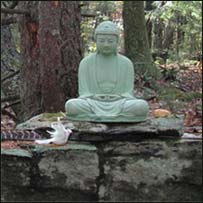|
|
 |
Please support Dharma Seed with a 2025 year-end gift.
Your donations allow us to offer these teachings online to all.

|

|

|
The greatest gift is the
gift of the teachings
|
|

|
| |
|
Dharma Talks
|
2021-06-07
Doing, Not-Doing, and The Doing That Comes from Not-Doing: In Meditation and in Daily Life
64:49
|
|
Donald Rothberg
|
|
|
We inquire into doing and not-doing in five ways: (1) identifying the importance of a number of different kinds of "doing" and skillful effort in meditation; (2) pointing also to the centrality of a kind of not-doing (or letting go of doing) and receptivity in meditation; (3) the importance of investigating the "doer" and one's identity as a doer, in a number of different ways, in meditation and daily life; (4) the vision of a doing that comes out of being, that comes out of a deep not-doing, a vision that we find in different spiritual traditions--here we mention ways that this vision is found in Jewish, Christian, Taoist, and Buddhist traditions; and (5) how we explore and cultivate this doing coming out of a deep not-doing in daily life, in "flow experiences," in activities in which we are deeply grounded, and in such areas as sports, music, art, and dance.
|
|
Spirit Rock Meditation Center
:
Monday and Wednesday Talks
|
|
|
2021-06-04
Day 6 Q&A2 – The Sacred, Body, Self and Other
47:37
|
|
Ajahn Sucitto
|
|
|
Trying to find triggers and safe space in the midst of health issues that affect nervous system, heart rate and breathing; stiff neck and shoulder muscles keep re-contracting; how to respond to getting so tired; what is the wise and caring response to body; navigating touch and contact skillfully; how can we be heirs to our kamma if there is no self to inherit it; through investigation of qualities of citta clarity and falling away has occurred – how to sustain; the more I see things clearly the more I feel the weight of delusion causing sadness and disgust and feeling of pointlessness for practice; how to approach in and out breath to calm mental activity (citta)/please speak to mindfulness of feeling from the Ānāpānasati Sutta.
|
|
Cittaviveka
:
Clearing the Floods - Dealing with Internal and External Overload
|
|
|
|
|